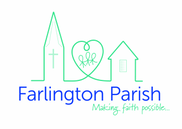What are Patrons?
The Rectors of Farlington are not chosen by the Bishop but by the patrons, one individual and a Foundation whose family have long connections with the Parish (though if the Bishop or the PCC representatives disapprove of the patrons' choice the matter may be referred to the Archbishop for a final decision). The present patrons of Farlington are the Nugee Foundation, four brothers who are great great grandsons of the Revd A.J. Richards, who with his father and grandfather before him served as Rectors in the parish from 1782 to 1925; and Mrs Sarah Wynter Bee, whose grandfather, Canon Leatherdale, succeeded A.J. Richards as Rector in 1925.
The right to present a priest to the Bishop for institution as Rector is a species of property, known in law as an advowson (from the Latin advocatio), the origins of which, in the Church of England, go back to at least the 12th century. The advowson of a rectory usually belonged originally to the lord of the manor. When the lord of the manor first built a church on land within his manor, he would endow it with glebe land, which produced an income to support the priest. The founder or endower of a church had the right to nominate such priest as he chose to officiate in that church, and became known as the patron. There is a list of the patrons of Farlington on the North wall of St Andrew's.
An advowson could have a substantial value, depending on the amount of the endowment; and until the 20th century it could be bought and sold like other property (the right became incapable of sale after the occurrence of two vacancies subsequent to 14th July 1924).
Fathers would sometimes buy an advowson which enjoyed a good income in order to provide a living for one of their sons, as happened at both Farlington and Wymering (where the Nugee brothers' great great-grandfather was Vicar - he married the daughter of the Rector of Farlington in 1854).
The first edition of the Clergy List in 1846 shows that Farlington provided an annual income of £529 for the Rector, in addition to a house, which was well above the average - of the 48 parishes on the same page of the 1846 Clergy List only four had a higher income, two of them by £10 or less (the annual income of the Vicar of Fareham was £530), although 15 parishes on that page had a larger population than Farlington's 793 inhabitants. (When Purbrook was first listed as a daughter church of Farlington, in 1859, the annual income of the perpetual curate was only £50, but it rose to £108 in 1874 when Purbrook became a separate parish.)
The patrons have no control over the performance of the Rector's duties once they have been instituted; but they hope that, if there is any way in which they can be of use or assistance, s/he will not hesitate to ask.
The Rectors of Farlington are not chosen by the Bishop but by the patrons, one individual and a Foundation whose family have long connections with the Parish (though if the Bishop or the PCC representatives disapprove of the patrons' choice the matter may be referred to the Archbishop for a final decision). The present patrons of Farlington are the Nugee Foundation, four brothers who are great great grandsons of the Revd A.J. Richards, who with his father and grandfather before him served as Rectors in the parish from 1782 to 1925; and Mrs Sarah Wynter Bee, whose grandfather, Canon Leatherdale, succeeded A.J. Richards as Rector in 1925.
The right to present a priest to the Bishop for institution as Rector is a species of property, known in law as an advowson (from the Latin advocatio), the origins of which, in the Church of England, go back to at least the 12th century. The advowson of a rectory usually belonged originally to the lord of the manor. When the lord of the manor first built a church on land within his manor, he would endow it with glebe land, which produced an income to support the priest. The founder or endower of a church had the right to nominate such priest as he chose to officiate in that church, and became known as the patron. There is a list of the patrons of Farlington on the North wall of St Andrew's.
An advowson could have a substantial value, depending on the amount of the endowment; and until the 20th century it could be bought and sold like other property (the right became incapable of sale after the occurrence of two vacancies subsequent to 14th July 1924).
Fathers would sometimes buy an advowson which enjoyed a good income in order to provide a living for one of their sons, as happened at both Farlington and Wymering (where the Nugee brothers' great great-grandfather was Vicar - he married the daughter of the Rector of Farlington in 1854).
The first edition of the Clergy List in 1846 shows that Farlington provided an annual income of £529 for the Rector, in addition to a house, which was well above the average - of the 48 parishes on the same page of the 1846 Clergy List only four had a higher income, two of them by £10 or less (the annual income of the Vicar of Fareham was £530), although 15 parishes on that page had a larger population than Farlington's 793 inhabitants. (When Purbrook was first listed as a daughter church of Farlington, in 1859, the annual income of the perpetual curate was only £50, but it rose to £108 in 1874 when Purbrook became a separate parish.)
The patrons have no control over the performance of the Rector's duties once they have been instituted; but they hope that, if there is any way in which they can be of use or assistance, s/he will not hesitate to ask.
